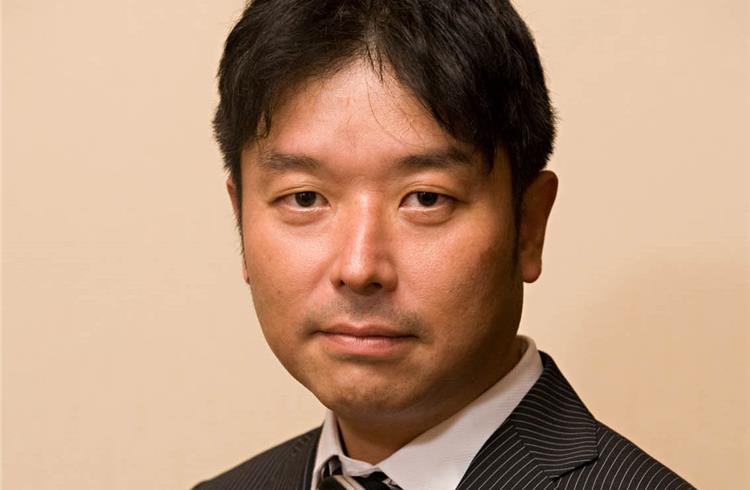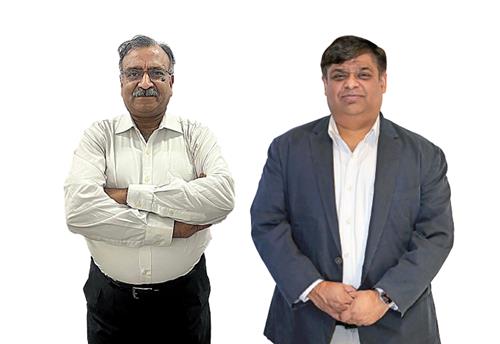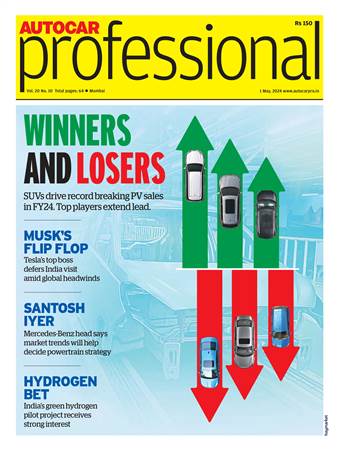‘We have been a little conservative in the past.’
In the Autocar-Bloomberg TV India ‘CEO On The Drive’ series, Naomi Ishii, Toyota Kirloskar Motor’s MD, speaks to Hormazd Sorabjee on the Etios’ styling, the Corolla and why Toyota should move faster in the Indian market.
It’s been a pretty tough couple of years for you. So what’s the market looking like right now?
The signs are good from the market, particularly after a new government has taken charge. We have seen good results since May and are getting more profitability as well. In terms of numbers for the Etios and the Liva, we are not doing as well we initially expected to.
Overall, buyers are happy with the product both in terms of space, especially in the rear seat, product quality, drivability and hassle-free maintenance. We need to find out who want to buy the car even though its exterior appeal is not very fantastic.
Was the Etios’s styling a fundamental mistake?
India has a diversified customer base. I will not believe that they are customers who like exterior only. We have to, therefore, go region by region and even within a city, cluster by cluster, for such customers and meet those who like our vehicles.
Toyota came into this segment with no past experience. Was this a challenge?
It was a challenge and we also had to handle the localisation aspect. If you take out the powertrain area from the vehicle, our localisation ratio is not bad.
What are the plans on powertrain as TKAP does a lot of exporting but is not used for domestic production. Will we see some optimisation going forward?
To localise the powertrain, one needs high volumes. One needs to utilise the materials, take into account all parts of the engine and the tools available. This has to be carefully assessed by R&D. To localise at a healthy manner we need more volume, that’s the fundamental aspect.
With your sales having fallen, will you tweak your capacity to be a bit more efficient and operate in these lower volumes?
We are working hard to sustain volume and the business itself. We are working with our dealers to push the volume up. The numbers may be fewer but from a business point of view, we are at a good position. Needless to say, we have to generate profits, push volume, improve product and achieve cost optimisation as well.
For the Etios, you talked about customers being happy but it appears to be an image problem. Do you think putting the car into the taxi market, especially in places like Mumbai, has hurt its image and will the focus be more on styling and less on the mechanicals in the future?
The taxi business may be good and bad. The positive aspect is that it helps sustain some volume and the negative is the image problem. According to dealers, the taxi image is not necessarily a bad thing. For some customers, that’s the proof of quality and reliability.
With the Innova, Toyota has sold a taxi and has been quite successful.
That is true but we have many customers so we really have to think about how to develop the market itself by tapping various opportunities.
The next-gen Etios styling is going to be aggressive, so is that a lesson learnt?
Yes, all our new models should have aggressive and better styling.
Has Toyota has been a little conservative?
Yes, in the past we have been.
There are other segments where you have gaps. Toyota does not have a compact SUV and a sub-four-metre sedan. In the below-Rs 10 lakh segment, you have only two models. Do you feel you need more products?
If we could have more models below Rs 10 lakh, we could have been in a better position than we are in now. We have to look at market realities and the resource allocation for us on a global basis.
Is resource allocation the biggest challenge for Toyota and that from an R&D viewpoint, you’ve not launched a real new product in the core segment since 2010?
That segment will see products in future. There are several factors that explain why we are in this condition. Resource allocation from HQ is one aspect. Indeed, we need more resources. I have been general manager of the planning department handling global resource allocations and I can say that Toyota is in a different position as compared to Honda, Hyundai or a Maruti when it comes to the focus on India.
So you have the rest of the world to worry about?
Each country has its own regulations, the competition, and we have to sustain the market. Perhaps it is time to adjust their resource allocation. Toyota is focusing on India. Earlier, the company did not know much about India and so the approach was cautious, step by step.
After the Etios and Liva, they got a bit worried. The relationship between India and Japan relationship is now a lot better. TMC is paying a lot of attention to India. I see may TMC executives visit India to see the market and meet with suppliers. So the consensus on how to approach India as a part of global arrangement is emerging.
Do you think this is a good time for you to have a small R&D setup in India?HQ may have the money but we don’t. India has a huge market potential and its market size could be about 10 million in 2025 or 2030. However, while the market size expectation is very attractive, so are the capabilities of the supplier base which is improving and becoming more competitive.
Can we see an R&D centre in India and would you like to have it personally?
At a personal level, yes but we need to get consensus from all the stakeholders. I would not want to wait until we get the consensus. We can start off with some outsourcing and utilising the R&D capability in India.
Isn’t this a very un-Toyota thing to do but you want to move very faster?Thank you for calling that un-Toyota but that is the only way to step forward quickly without depending on the headquarters.
Let’s move to the IMV platform. Is this the backbone for Toyota India — the Innova and Fortuner?
We see the more affluent customer buy more upper-segment models as a result of the economic growth and the new government. I see a big opportunity in expansion and particularly maybe the price range for the Innova and Fortuner as there are many upper middle-class customers looking for something new.
The demand for these vehicles will increase due to the usage and the diverse customer demand. Toyota is a renowned brand for SUVs and MPVs globally. The expansion of the affluent customer base will grow the demand for these products.
The Innova’s price has gone up by about 60 percent since its launch. Are you being a little too ambitious in pricing?
The customer who wants the Innova is not only happy with the product but as far as pricing goes it is value for money. The product has quality, reliability and durability. One proof is that the Innova is the only MPV to win the JD Power award in three categories — the IQS, the APEAL and the BDS — in a consecutive manner for six years since launch. That is the proof of balance between product and prices.
Does the fact that it has no strong competition help?
The newcomers in MPVs – the Mobilio and Ertiga – are not identical to the Innova but yes there is small overlap. Thus far, we do not see any influence of the newcomers on the Innova.
The new MPVs are doing a lot on the styling front. Do you think that in the future Innova, styling will play an important role and you can charge more on the pricing?
Yes, better styling without sacrificing the selling point which is space. Apart from styling which is one trend, the other is the balance between form and function; so from that perspective, styling is very important. I do not think we have to go for more styling on the Innova which may cause problems to the customers for functionality.
The Corolla is in the executive segment which has collapsed over the years. This, therefore, doesn’t give you great numbers but was it important to bring it because it is a global brand?
This is a small segment in which our share is over 50 percent. In the future, these segments will get larger and we wish to grow in this segment. The drivers of the market are basically three: fuel efficiency, energy security and emissions. In order to promote globalisation and modernisation in India, it is important to have the Corolla as the leader to promote these three factors.
Customers are only willing to pay for fuel efficiency, so is that a challenge for Toyota to also bring in the safety and efficiency aspects?
At one point, no one wanted to pay for safety or emissions in Japan but gradually customers began to look at the future. That will happen here too as all the stakeholders including the government, manufacturers and customers come together.
You have a Camry hybrid. Are we going to see more hybridisation in India?You will see more hybridisation going forward but at this point in time, the awareness of hybrid is very low. The Camry Hybrid accounts for 60 percent of all Camry sales. In the initial stage, people bought the car for its features. However, more recently, we have tried to explain what is a hybrid.
At the same time, many customers have had an exposure to hybrids in the US and in Japan and have approached us.
Do you think the biggest challenges for the hybrid car is the gap in petrol-diesel prices?
That will be a challenge but we also need to think about exhaust emissions. Once regulations become tighter at Euro 5 and 6, diesel will have the challenge and hybrids will have a problem with better fuel efficiency and better emissions.
I think it’s just a matter of timing for the hybrids but definitely future hybrids will be the main course of the market.
Toyota’s quality has been legendary even as we have criticised your styling. What is it about Toyota quality that you manage in each of your cars even in India where the basic culture is about not giving the quality?
For us, quality is at the core of the brand – we call quality first and safety a must. So to maintain that quality of the vehicle, we have a very good global system and monitoring the following five things: quality, process, cost and also productivity, HRD and safety. These aspects ensure perfect quality. At Toyota, our aim is to share all these practices in each affiliate and maintain the best in all practices.
RELATED ARTICLES
‘‘Retrofitting can be a better option than investing in new commercial vehicles’’
Mechanically sound old diesel vehicles can be given a second working life as a clean vehicle, by retrofitting them with ...
Setrans Mobility Booster Charging top-up 25% EV range in 15 minutes
Two enterprising tech-savvy entrepreneurs Rana Roshan Singh and Vivek Ummat of Noida, Uttar Pradesh-based start-up Setra...
'Our products are proudly 100% designed and made in India'
Creatara Mobility, a New Delhi based electric two-wheeler startup, claims to have tackled various challenges in making i...





 14 Nov 2014
14 Nov 2014
 3480 Views
3480 Views





 Autocar Pro News Desk
Autocar Pro News Desk




